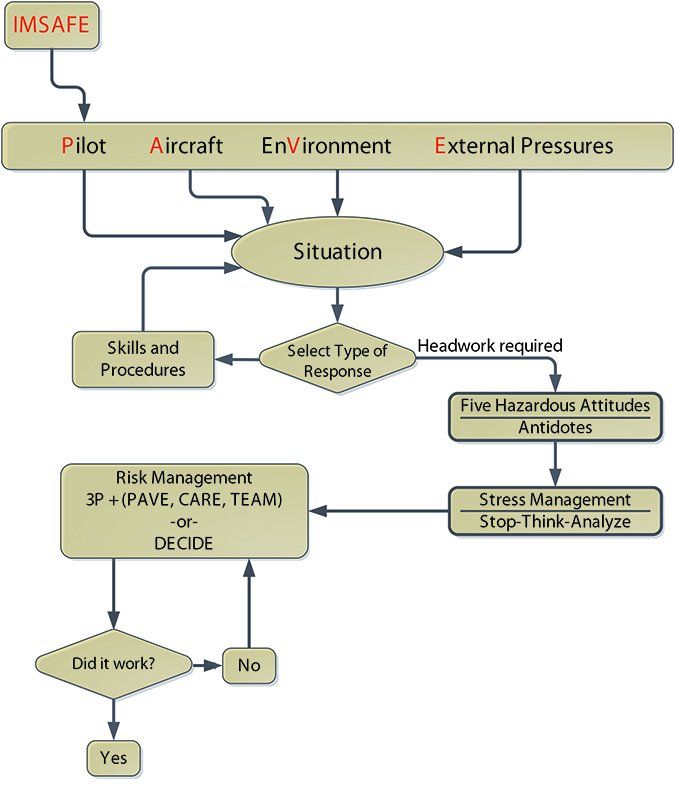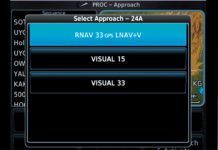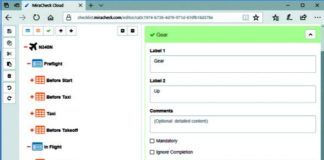We all know most accidents are caused by pilot errors in judgment, reasoning, or skill. We learn through our mistakes. But, we can’t make (and survive) all possible mistakes ourselves. So, the FAA tries to teach us good judgment and reasoning.
In AC 60-22, Aeronautical Decision Making, the FAA claims that good judgment can be taught besides being learned from experience. Aeronautical Decision Making, ADM, builds upon conventional decision making to help decrease the likelihood of errors in the cockpit. It is a structured, systematic approach using risk-management tools called PAVE and DECIDE.
Validating ADM, the AC cites a study where student pilots who received ADM training made 10-50 percent fewer judgment errors than untrained students. This is why the new Airman Certification Standards incorporate a risk management component into every task to promote learning and applying risk management during flight training.
Yet learning ADM is challenging in part because much FAA documentation is, frankly, poorly organized and excessively wordy. These and other weaknesses can make it difficult to learn and apply the various ADM tools: PAVE, PPP, CARE, TEAM and DECIDE. That’s where we come in, providing a cohesive diagram and some text that shows where everything fits and how it all works together.
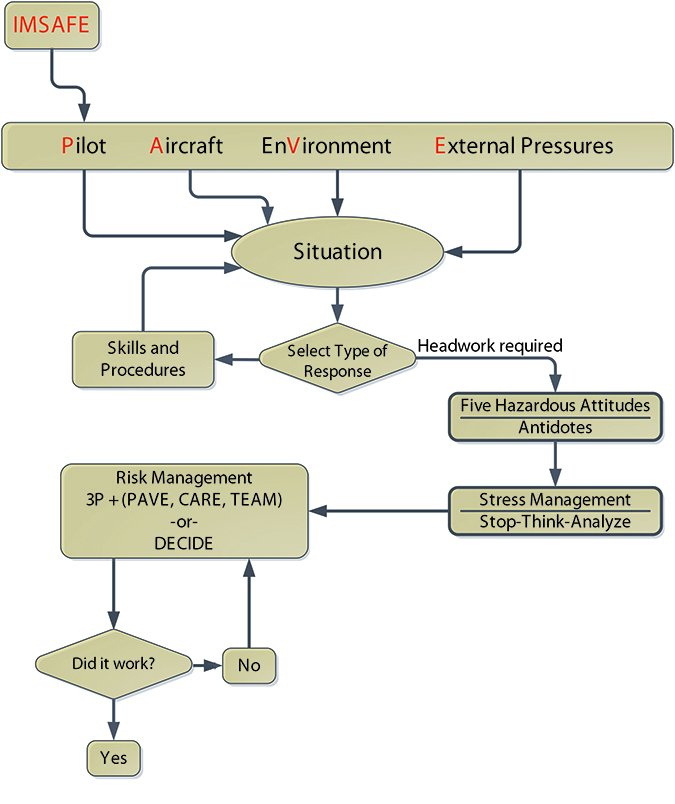
PAVE the Way
PAVE defines the four major hazards of flight: Pilot, Aircraft, enVironmental and External. Hazards create risk, making PAVE critical in risk management and ultimately preflight and in-flight aeronautical decision-making.
P = Pilot
The IMSAFE checklist helps you—the PIC—assess yourself physically before any given flight. It’s fine as a medical arbiter of your fitness to fly, but IMSAFE alone is insufficient. Are you adequately experienced to do the trip? If carrying passengers, are you current? How about instrument currency? Do you have a current flight review? You get the idea.
A = Aircraft
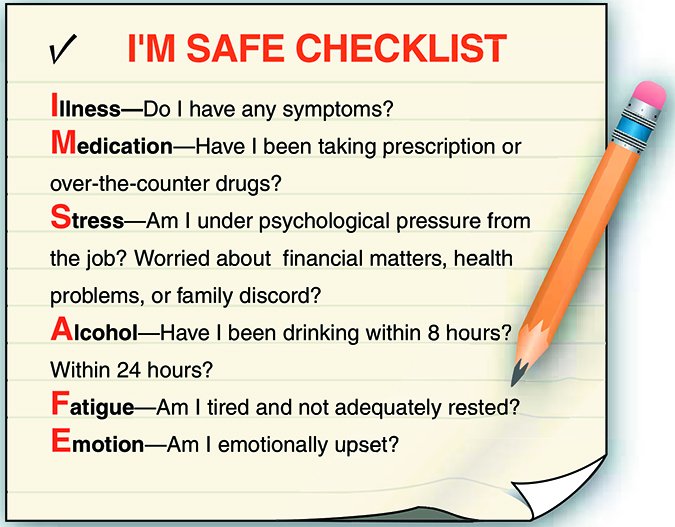
Is your aircraft up to the task? A 160-hp Cessna 172 may not be the right aircraft for a departure from a high-density-altitude airport. Many instrument pilots will not fly single-pilot IFR without a working autopilot. Well, how about if it’s half-working? Would you fly a two thousand-mile round-trip in a Cirrus SR22 if the vertical modes in the autopilot were broken? I declined just such a flight recently. The outbound leg would have been partly at night. Who could know if the horizontal modes might fail next and leave us with no autopilot in an airplane designed to fly on autopilot?
Some aircraft (e.g., Cessnas with G1000 avionics) have a Kinds Of Equipment Listing (KOEL) that specifies the aircraft components required for day/night IFR/VFR. Have you applied it to your aircraft? Is the GPS database current?
V = EnVironment
We look askance at the weather forecast, knowing that it’s an educated guess, and that it becomes more accurate with time and evolving into actual weather.
Expected ceiling and visibility at the destination matter. You might have to fly an approach to minimums, perhaps declare an alternate and be prepared to fly it. Time can be your friend or enemy; what’s the weather trend?
Winds aloft can take a serious bite out of your range. Wind at your destination may not favor the preferred instrument runway. Is another runway available? Could you circle to land? Could you and your aircraft handle the crosswind? Are you prepared for that?
Safe VMC havens along your route are always smart in case you need to get to VMC in a pinch. It could be right under you if the ceilings beneath you are above the OROCA, MEA or MOCA.
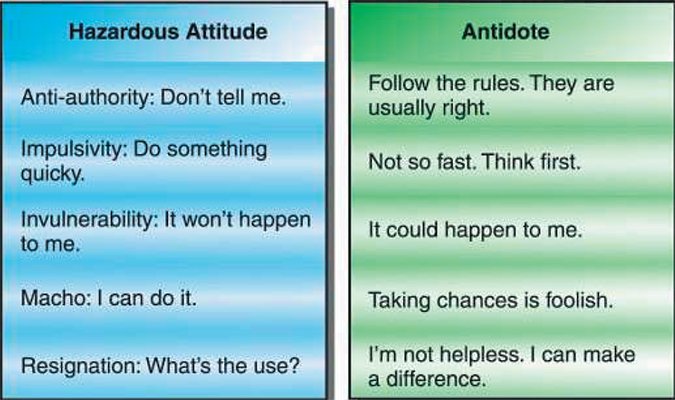
Electronic planning tools should automatically show you enroute and destination NOTAMs including airspace restrictions and TFRs. If you brief via FSS, ask for published NOTAMs. Once a NOTAM is published, FSS assumes that you have read it.
Environment also means terrain. Are you qualified and prepared for the terrain you’ll encounter? Can your aircraft handle it? Will the terrain in the vicinity of your destination cause any additional weather or wind concerns?
E = External Pressures
Another old saying tells us that takeoffs are optional while landings are mandatory. Although you may have a personal need to reach the destination, there’s nothing mandatory about making that flight. The safest word in aviation is “No.” In the Cirrus case above, the person requesting the trip was a bright but rusty, low-time instrument-rated private pilot. He was never taught how to properly evaluate a proposed trip. It is for people like him that risk management and aeronautical decision-making tools are so important.
Pilots are often mission-oriented people. That makes us very susceptible to external pressures. One could say that you hold a license because you have been trained to recognize unacceptable risk. Nonpilots often equate GA with airline reliability, giving them unrealistic expectations as to our capabilities. Therefore, simply set expectations where they need to be.
If you elect to go, take more pressure off yourself by briefing the passengers that this will not be like flying in coach. It could be bumpy. Ask passengers whether they are can handle you landing at other than your destination or even turning back. If someone is prone to motion sickness, yours could be an extremely uncomfortable trip without medication.
Leave yourself several outs. You would do this anyway during preflight planning; it also takes pressure off you. GA flights seldom depart as planned and usually take longer than expected. Add extra time to your ETA because unpredictable delays are inevitable. Leave your last hour of fuel in reserve. Take more pressure off yourself by telling someone meeting your flight to be there well after your planned ETA.
Selecting a Response Type
There are two ways to respond to change identified through PAVE. It could be something as simple as making a course correction, setting trim or power. These automatic responses as skills or procedures don’t—or shouldn’t—require much thought. They include immediate action items and emergencies. You flow around the loop on the left until the situation is under control.
Some responses call for analytical “headwork” and this is why the right-hand loop exists. The first stop is Attitude Management.
Attitude Management
Five hazardous attitudes can be mitigated by the proper antidote—but you first must recognize the attitude. If you have low oil pressure, telling yourself that it’s not happening and the gauge is wrong isn’t helpful. If instead you accept that it is happening, then move to the next step.
Stress Management
Airborne, stress management can be reduced to three simple words: Stop, think, analyze. It is better to do nothing than the wrong thing. Some say that the first thing to do in an emergency is to “wind your watch.” However dated, the dictum is sound: Take no action until you think through which action is best. Doing so helps prevent jumping to incorrect conclusions and/or making things worse. You may also have heard, “No fast hands in the cockpit.” However you choose to remember, slow down and think things through.
Headwork Responses
The FAA’s approach to ADM and Risk Management has evolved since the Pilot’s Handbook of Aeronautical Knowledge (PHAK) addressed it in 2008 and again in 2016. Risk Management occurs when headwork is required and decisions are made.
The PHAK offers us two models for practical risk management. The first invokes the Perceive-Process-Perform or 3P model combined with PAVE. We evaluate PAVE-identified hazards using something called the CARE checklist. Finally, the TEAM checklist offers ways to eliminate or minimize risks identified by CARE.
The second model is the better-known DECIDE model. We’ll discuss both.
Perceive, Process, Perform (3P)
The 3P model is one way of making aeronautical decisions. First, Perceive a given set of circumstances for your flight using PAVE. Then Process the circumstances by evaluating their effect on flight safety with CARE. Lastly, Perform the best course of action using TEAM. This process should run in your mind over and over until it becomes habitual.
PAVE Identifies Hazards
PAVE identifies hazards, and hazards create risks. Once a hazard is identified, the CARE model processes it to see if the hazard is a risk. The PHAK defines risk “as the future effect of a hazard which is not controlled or eliminated.”
The degree of a risk can be weighed in terms of exposure, severity and probability. An exposure could include the number of people or resources that would be affected. Severity is the extent of possible loss. Last, what is the probability that a hazard will cause a loss? Paraphrasing the PHAK, “why should you CARE about these circumstances?”
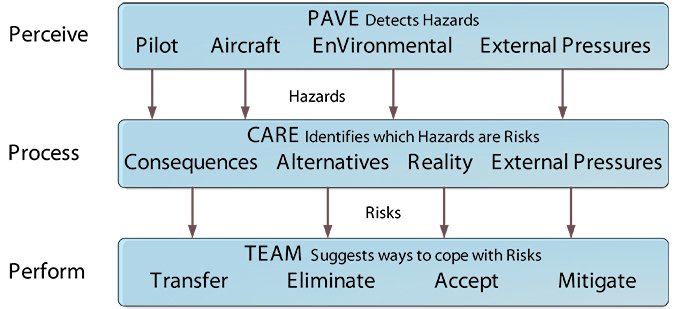
CARE
The CARE model has four elements: Consequences, Alternatives, Reality and External Pressures.
Does the hazard identified by PAVE have consequences? ATC advises of severe weather along your route of flight. That’s a definite risk that could have unpleasant consequences.
Now, alternatives. Could you deviate to bypass the weather? Is diverting an option? Can you ask or does ATC have a suggestion that might be a viable way around Mother Nature’s ferocity? In flight, always be considering alternatives. Apply 3P. Never just sit and drive.
The reality could be that the weather is all well below your altitude, meaning alternatives are unneeded. Or you could be facing a sickly-green monster with lightning everywhere and reality dictates that continuing is impossible.
External pressure is the most dangerous of all risk factors because these pressures cause pilots to ignore all other risk factors. Your gut knows the truth. Never ignore that little voice of reason.
TEAM
Aware or not, you’re applying 3P: You Perceived a hazard using PAVE. You Processed its effect on flight safety with CARE. It’s time to Perform risk management using TEAM to achieve the outcome that reduces or eliminates the risk most effectively.
Perhaps you could Transfer the risk decision to someone else, say the CFII to your right or to the PIC if you’re SIC. Clearly, this doesn’t work for single-pilot operations.
You might be able to Eliminate the hazard. For instance, skip bad weather at your destination by diverting to your alternate.
In some cases, you can Accept the risk if the benefits outweigh the costs. You might be better off landing on a shorter runway into a stiff wind rather than dealing with it as a crosswind.
Regardless of other factors, it’s always a good idea to Mitigate the risk, lessening its effect. Say you’ve got a long leg over water. Plan your routing to shorten it as much as practical.
In sum: Act to eliminate hazards or minimize risk, then continuously evaluate the action’s outcome.
DECIDE
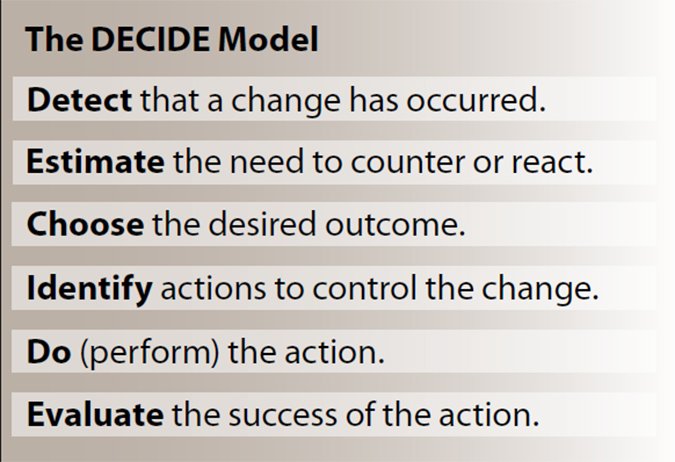
Recognized worldwide, DECIDE is a simple six-step continuous loop offering you a logical way to make decisions.
Your senses Detect that an unexpected event occurred. You use your insight and experience; you objectively analyze all available information. Then you Estimate the nature of the issue and how severe it might be. A caution: If you incorrectly define the problem, incorrect decision-making will follow.
Choose a course of action that leads to a desired outcome. Many pilots have an issue here. They know the right thing to do, but mistrust their judgment. Example: They see they are high or low on final, yet fail to reduce/add power to make a safe landing.
The above means that the pilot has failed to Identify one or more solutions that will lead to a safe landing. Frozen by indecision may mean no decision and hence no corrective action.
All the above is for naught if the pilot doesn’t Do something. Once corrective actions are decided, the pilot has to implement them.
It’s not over until it’s over. Evaluate the action to see if it worked. If not, the DECIDE model may have to be run again.
Decisions, Decisions
Which risk management model is best? PAVE/CARE/TEAM has more steps, but excels at separating hazards from risks and mitigating risks. DECIDE is simpler, but offers less structure. Tape a copy of the models in your cockpit or scan both models into your iPad. Use them both to see how they work for you. Whichever you choose, better cockpit decisions will result.
Fred Simonds, CFII, makes better decisions when he has all these acronyms straight in his head. See his web page at FredonFlying.com.

